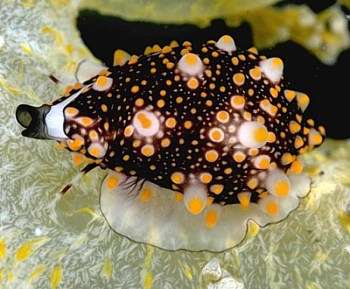
Ovulids (False Cowries)
Superfamily: CYPRAEOIDEA
Family: Ovulidae
PHOTO
Ovula ovum on its food - a soft coral. Note the mantle flaps covering the shell. Koumac, New Caledonia, October 1993. PHOTO: Bill Rudman.
The ovulids (Family Ovulidae) are cowry shaped snails with large colourful mantles which usually completely cover the shell. In many ways they have evolved defensive strategies which mirror those found in the nudibranchs. They have bright colourful bodies and retain noxious chemicals from their food. These chemicals are stored in their skin where they can protect the snail from fish predation. In the photo above, the only part of the shell that is visible is the white region at the front (left side of photo) of the animal. The black tube (also at the front) is the siphon which directs water into the mantle cavity inside the shell. If you look at the base of the head tentacle (below the siphon) there is a black swelling which is the left eye. One easy way to separate snails from slugs is to look for their eyes. If they are raised from the skin like this then they are a snail. If the eyes are embedded in the skin they are an opisthobranch. Externally they look very like the Cowries (Cypraeidae).
Related messages
Ovula ovum with eggs from Tofo, Mozambique
August 23, 2007
From: Natasja Vandeperre
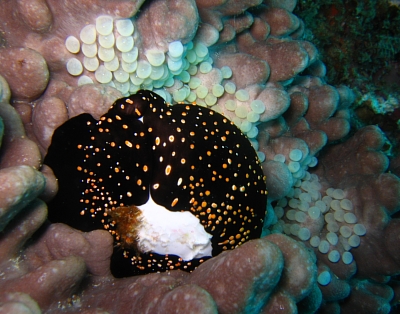
Dear Bill,
Here is a picture of Ovula ovum with it's eggs from Tofo, Mozambique.
Locality: Tofo, Mozambique, Indian Ocean, 20 July 2007. Photographer: Natasja Vandeperre.
Best wishes,
Natasja
postmaster@naaktslakken.be
Natasja Vandeperre, 2007 (Aug 23) Ovula ovum with eggs from Tofo, Mozambique. [Message in] Sea Slug Forum. Australian Museum, Sydney. Available from http://www.seaslugforum.net/find/20506Dear Natasja,
Thanks for this photo. I don't want to become a False Cowry Forum, but a few photos showing some aspects of their biology are always welcome.
Best wishes,
Bill Rudman
Ovula ovum from Indonesia
May 22, 2007
From: Carrie Lo
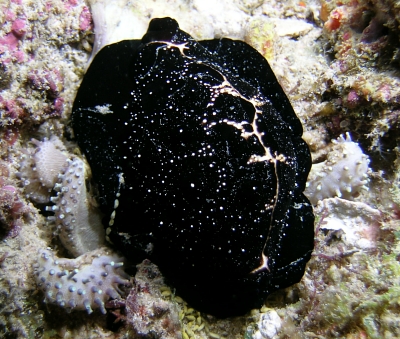
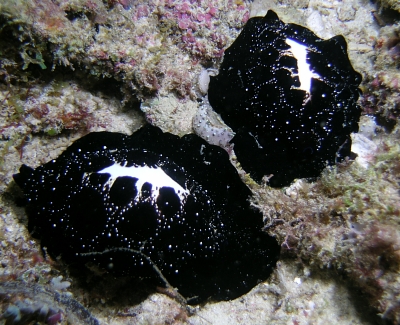
Dear Bill,
Not sure if these are sea slugs. The first 2 pictures are taken at 6:30am on 27 April 2007 in Derawan at 15m water. In the second picture there is an opening in the middle of the black skin, underneath is something white and hard. Would these be Pleurobranchus forskalii?
Locality: Derawan, 15m, Indonesia, 27 April 2007. Length: 5 inches. Photographer: Carrie Lo.
The third picture showed 2 similar pieces found n a coral in Mabul, Sipadan, [Sabah, Malaysia] at 7:30 pm on 14 June 2006 at 10 m water.
Best regards,
Carrie
carrielohc@yahoo.com.hk
Lo, C., 2007 (May 22) Ovula ovum from Indonesia. [Message in] Sea Slug Forum. Australian Museum, Sydney. Available from http://www.seaslugforum.net/find/19910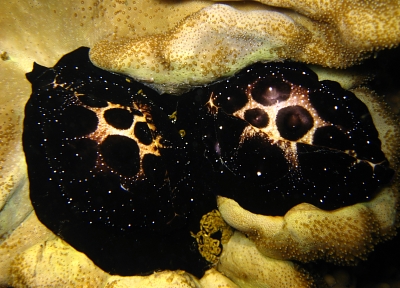
Dear Carrie,
The hard white bit is the clue to this animal's identity. It is the top of a large hard egg-shaped white shell which gives this 'false-cowry' its name Ovula ovum both words referring to an egg. Have a look at the Ovulid Fact Sheet for more information. They feed on large leathery soft coral colonies, and you can see the animals in the bottom photo are nestled in such a soft-coral colony. In the uppermost photo the colony seems to have been completely eaten except for a few fragments in the lower left corner.
Best wishes,
Bill Rudman
Ovulid from Sydney
December 1, 2006
From: Sean McMahon
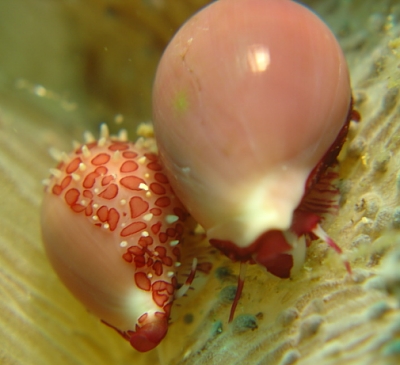
G'day,
I realise that this is a little off topic but I noticed that you have a few allied cowries on your website. I found these little guys only on one clump of the softcoral Capnella gaboensis, although there were a lot more of the same softcoral present. They are also very small at around 10 mm in length. I'm not 100% sure but I think they are Globovula cavanaghi.
Locality: Reef off Oak Park , Cronulla, 7.5 meters, NSW, Australia, Tasman Sea, 2 October 2006, on softcoral on rocky reef, Length: 10 mm. Photographer: Sean McMahon.
Regards Sean.
spmcmahon24@yahoo.com.au
McMahon, S.P., 2006 (Dec 1) Ovulid from Sydney. [Message in] Sea Slug Forum. Australian Museum, Sydney. Available from http://www.seaslugforum.net/find/18666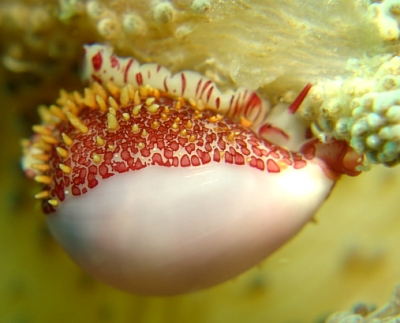
Dear Sean,
You are right - I certainly don't want to become tangled up in snail identifications. I have a few ovulids on the Forum because they are often mistaken for nudibranchs, and in many ways they have evolved similar defensive strategies - bright colours and the storing of noxious anti-feedant secondary metabolites from their prey, to use in their own defence.
Both Prionovolva cavanaghi (Iredale, 1931) and Prionovolva brevis (Sowerby, 1828) are found around Sydney, but unfortunately most ovulid taxonomy has been done on the shell rather than the animal, but there are a few enlightened souls who have seen the error of their ways. The animal colouration looks very similar to P. brevis. All I am willing to say is that it is almost certainly a species of Prionovolva.
Best wishes,
Bill Rudman
Ovulid snail from Malaysia
August 26, 2006
From: Sven-Urban Fjellner
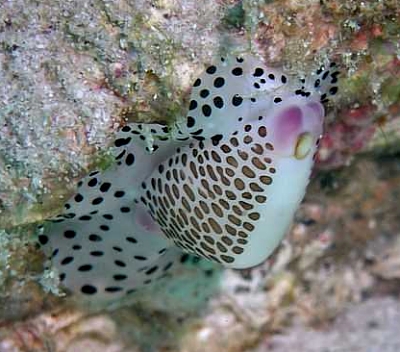
Dear Bill,
Having looked through all(!) species on this web site, I am still at a loss understanding what this is - if at all a sea slug. To me it sort of resembles a pleurobranch, but I realise it might be something completely different - even a cowrie (I never checked whether it had a shell or not).
Locality: Pulau Redang, 12 - 18 m, Malaysia, South China Sea, 24 July 2006, Reef. Photographer: Sven-Urban Fjellner.
Sven-Urban Fjellner
diver@kanakoto.net
Fjellner, S-U, 2006 (Aug 26) Ovulid snail from Malaysia. [Message in] Sea Slug Forum. Australian Museum, Sydney. Available from http://www.seaslugforum.net/find/17529Dear Sven-Urban,
This is an ovulid snail, Calpurnus verrucosus, which feeds on large soft corals such as Lobophyton. Have a look at my comments in an earlier message [#8038]. The white bit is in fact its shell and there are black-spotted flaps which fold up each side to partly hide the shell, much like in the cowries. Ovulids are often called 'false-cowries', but they are a distinct group which feed on soft corals. Interestingly many of them.have evolved brightly coloured mantles which partly or fully hide their shells, so they look quite slug-like.
Best wishes,
Bill Rudman
Cowry or False Cowry or ???
March 1, 2006
From: Pasquale Pascullo
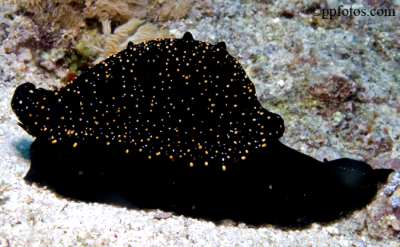
Bill thanks.
I was shooting a penis fencing session btwn Lindae flatworms when my buddy called me over for this. We looked at each other like, what is it? I took a bunch of shots and went back to Lindae, but I am not sure here what we have.
Snail or slug or cowry or ?
Again thanks for your time and all you do for this site.
Locality: Pemba Islands, 40ft, Tanzania, East Coast Africa, Indian Ocean, Feb 9th '06 , rocky, sandy hard slanted floor. Length: a good 12 inches. Photographer: Pasquale Pascullo.
Pasquale
pp@ppfotos.com
Pascullo, P., 2006 (Mar 1) Cowry or False Cowry or ???. [Message in] Sea Slug Forum. Australian Museum, Sydney. Available from http://www.seaslugforum.net/find/15963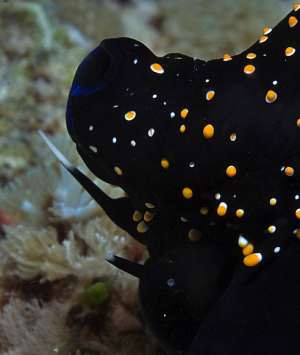
Dear Pasquale
This is an ovulid or false cowry, and from its size and colour I assume its Ovula ovum, the egg cowry, which feeds on large leathery soft corals like Sarcophyton. In Gosliner, Behrens & Williams (1996) there is a photo of a juvenile which they suggest may mimic the toxic Phyllidia madangensis. It would be interesting to know if juvenile Ovula ovum in East Africa had the same juvenile colour form.
- Gosliner, T. M., Behrens, D. W., and Williams, G. C. (1996) Coral Reef Animals of the Indo-Pacific. Monterey, California, Sea Challengers. 1-314.
Best wishes,
Bill Rudman
What's this interesting beauty?
August 28, 2003
From: Gary Cobb
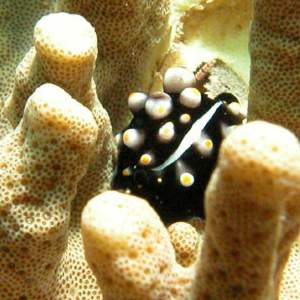
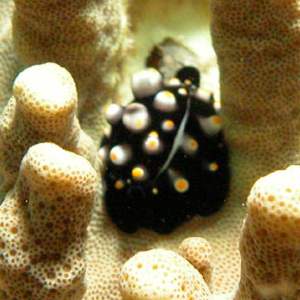
Hi Bill
Can you help me ID this little beauty?
Found at Vanuatu, [site: Hideaway 1]
depth:10m
lenth: about25mm
2 April 2003
There seems to be an interesting white line on it ... does this mean anything? Is the little critter infected? Sorry I did not get a better shot.
Thanks
Gary Cobb
gary@cobb.com.au
Cobb, G., 2003 (Aug 28) What's this interesting beauty?. [Message in] Sea Slug Forum. Australian Museum, Sydney. Available from http://www.seaslugforum.net/find/10734Dear Gary,
This is not a sea slug at all, but one of a family of snails [Ovulidae] which have large, often colourful mantle flaps covering much of the shell. The white stripe you inquire about is all you can see of the white shell, almost totally obscured by the black mantle flaps. It is probably feeding on the soft coral it is photographed on
Best wishes,
Bill Rudman
West Indian ovulid in Bonaire
May 27, 2003
From: Sebastian Schulherr
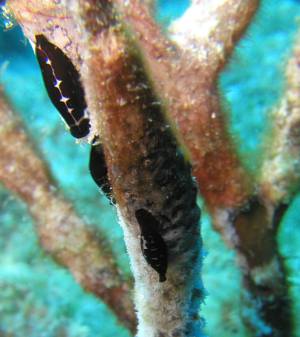
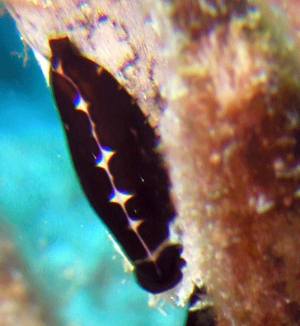
Bonaire is in the Netherland Antilles, the Dutch Caribbean, near Aruba and Curacao, about fifty miles north of Venezuela. April 22 we were taking a late morning dive north of Small Wall, famous for the underwater webcam nearby. We found these guys in fifty feet seawater in a sloping reef of sand and coral heads on a gorgonian. Using the Paul Humann Reef Creatures book we tentatively identified them as West Indian Simnia by the little white bumps on their sides.
We only picked up a digital camera housing last year, after we had between four and five hundred dives under our weightbelts. We dive in Bonaire a lot, and like to find interesting new things. Digital pictures beat my slate sketches hands down.
Sebastian Schulherr
nyfx@earthlink.net
Schulherr, S., 2003 (May 27) West Indian ovulid in Bonaire. [Message in] Sea Slug Forum. Australian Museum, Sydney. Available from http://www.seaslugforum.net/find/10004Dear Sebastian,
I have a few 'slug-like' animals on the Forum to illustrate just what is not a slug, but I can't go into any detail about them or I would be swamped with messages on ovulids, flatworms etc. This is indeed an ovulid, sometimes known as 'false cowries'. Many, like your animals, feed on gorgonians and hide their shells with, often colourful, flaps of skin.
We are certainly interested in photos you take of any sea slugs from the Caribbean. We don't know very much about these animals in the Caribbean so any new information and photos of living animals is potentially very valuable. Even photos of things you think are common could be useful as we have very little idea about their distribution throughout the region or their colour variation.
I look forward to hearing from you,
Bill Rudman
Calpurnus verrucosus from Red Sea
September 25, 2002
From: Michael Mrutzek
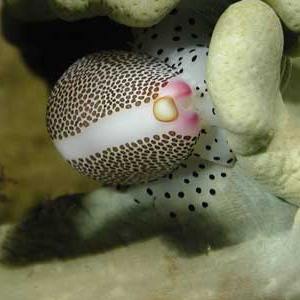
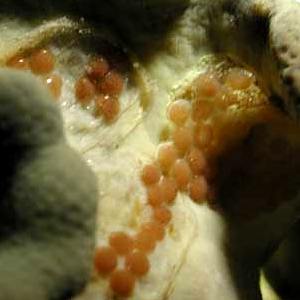
Dear Bill,
Here are two photos of another slug from the Red Sea for use in the Forum. It was photographed at Erg Estha, a reef off Hurghada, on the Red Sea coast of Egypt, August, 2002. 15 meters on soft coral Sarcophyton. The lower photo shows its eggs. Photo Copyright: Michael Mrutzek
Michael
Mrutzek@meeresaquaristik.de
Mrutzek, M., 2002 (Sep 25) Calpurnus verrucosus from Red Sea. [Message in] Sea Slug Forum. Australian Museum, Sydney. Available from http://www.seaslugforum.net/find/8038Dear Michael,
This is an ovulid snail, Calpurnus verrucosus. Although not a slug, I have a page for the Ovulidae, because when they have their often colourful mantle extended out over the shell, they can be easily mistaken for slugs. In this species, the black spotted folds of the mantle almost completely enclose the white shell.
In fact ovulids seem to have evolved the ability to store noxious chemicals from their food, in their bodies. Like many nudibranchs, which do the same thing, these chemicals can then be used as part of the snail's defensive strategy.
Best wishes,
Bill Rudman
Please help! - animal on gorgonian
September 3, 2002
From: Adam Bright
Recently I found a yellow gorgonian in about two feet of water (North Carolina, USA, Atalantic Ocean June 3,2002). It was about 1/2 mile up in the mouth of a river(from the ocean). It came from a sandy to muddy bottom. On the gorgonian I found a slug/snail of some kind. I have placed it in my tank and it has grown from 1cm to 2.5cm in three months. It is the same color yellow as the Gorg. It omly stays on the gorg. and it has a beautiful pattern of black tiny dots. It has quite an odd shape. It is long and narrow and comes to a precise point at both ends. The pattern of dots is on its flesh which wraps around its shell like a cowry. It seems to be doing well in the tank so far. I would just like to know what it is and any info on it. Thanks!!
Sorry no pic!
Adam Bright
vanessajoybright@hotmail.com
Bright, A., 2002 (Sep 3) Please help! - animal on gorgonian. [Message in] Sea Slug Forum. Australian Museum, Sydney. Available from http://www.seaslugforum.net/find/7874Dear Adam,
From your description I would say your animal is a snail of the family Ovulidae - often called 'false cowries'. Many species live exclusively on gorgoniids. The shell is often elongate and covered by flaps of the brightly coloured skin. Some species use their shape and colour to camouflage themselves on their host gorgonian while others have a bright colour pattern which makes them startlingly obvious. Many of them store noxious chemicals, which they obtain from their food, for their own defence. In both their bright colours and the chemical defence they mimic they behaviour of many nudibranchs. [see page on opisthobranch colour].
Best wishes,
Bill Rudman
